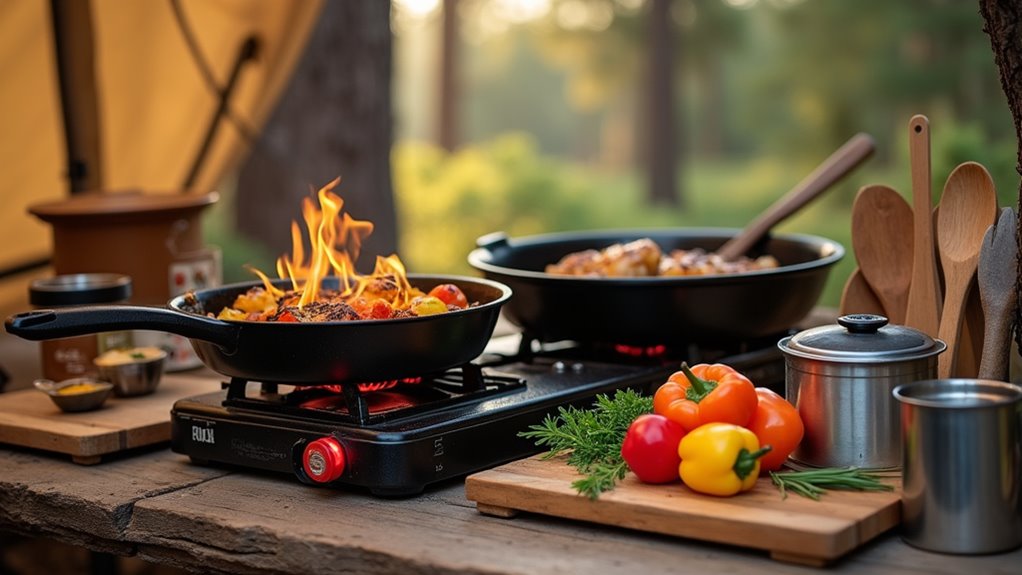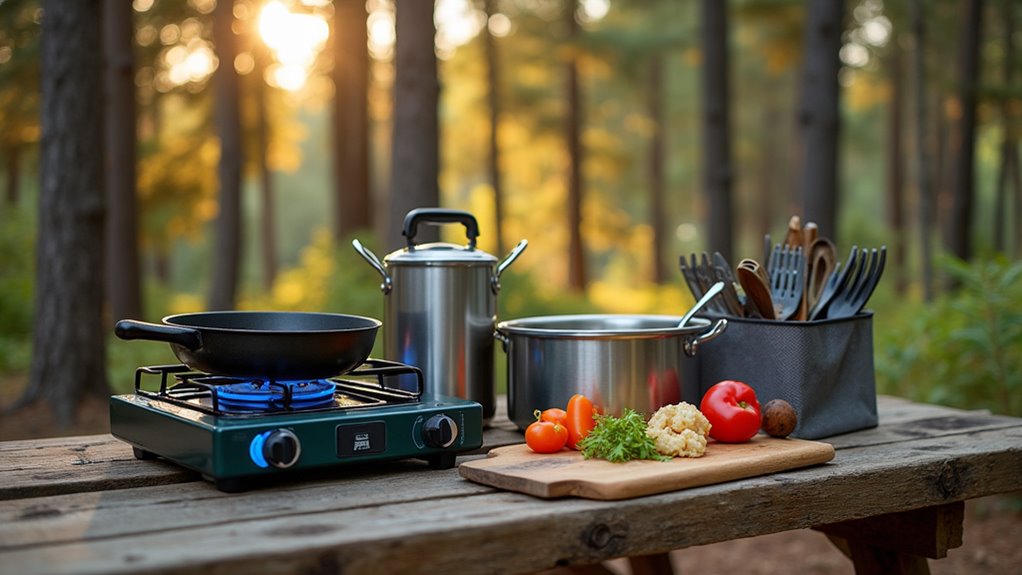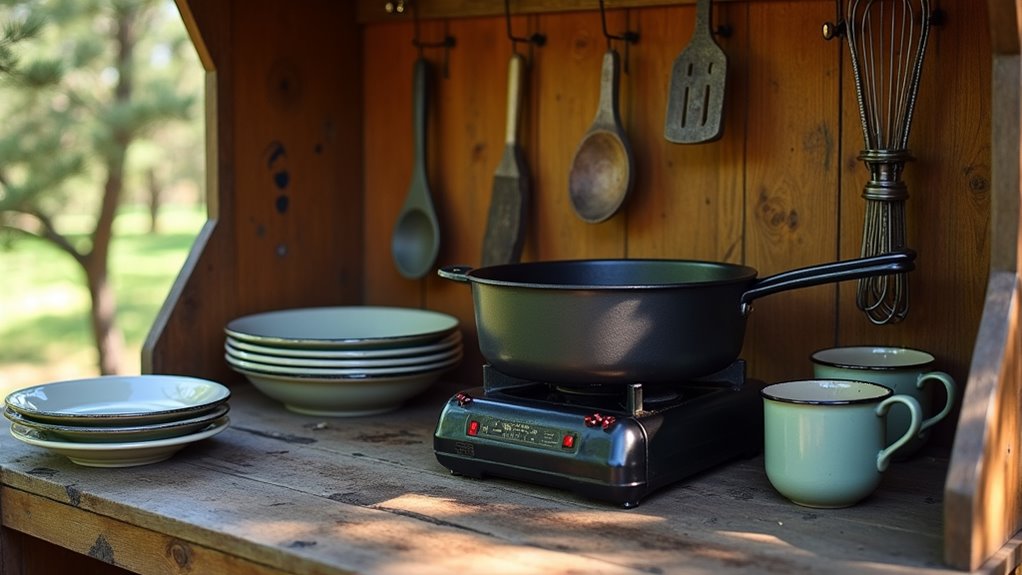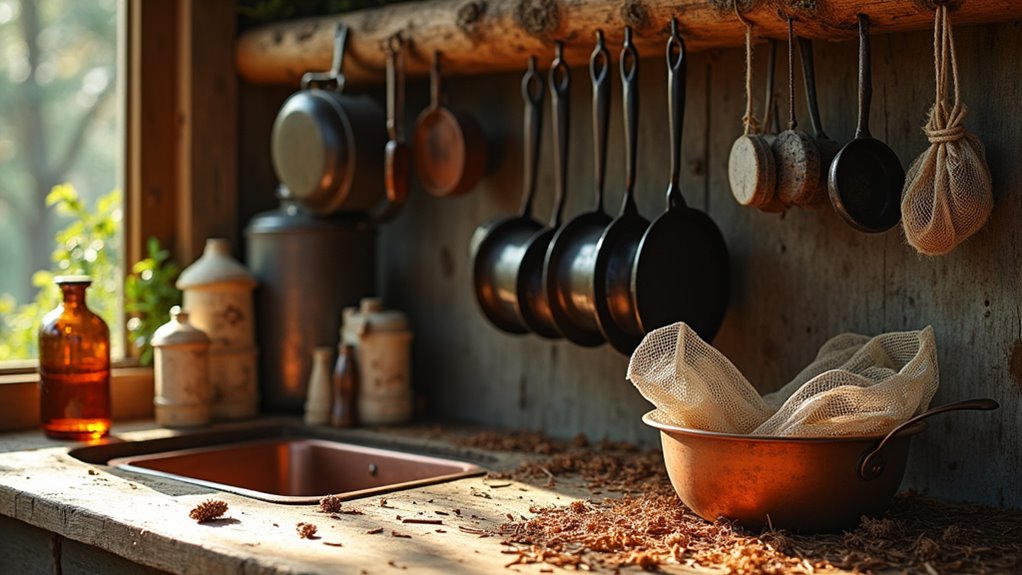Physical Address
304 North Cardinal St.
Dorchester Center, MA 02124
Physical Address
304 North Cardinal St.
Dorchester Center, MA 02124

Set up your dream camping kitchen and unlock the secrets to creating mouthwatering outdoor meals that'll make every adventure unforgettable.
You’ll discover that a well-organized camp kitchen transforms ordinary outdoor meals into memorable culinary experiences. When you’re miles from home, having the right setup makes all the difference between a basic sandwich and a hearty, hot meal under the stars. From selecting essential gear to mastering outdoor cooking techniques, there’s an art to creating your perfect wilderness kitchen. Let’s explore how you can elevate your camp cooking game and make every outdoor meal count.

When planning your camp kitchen setup, having the right gear makes the difference between a frustrating experience and a smooth outdoor cooking adventure.
You’ll need a reliable camp stove compatible with propane fuel, along with small and medium-sized cook pots with lids. Don’t forget a sturdy frying pan for sautéing and essential utensils like spatulas, cooking spoons, and tongs.
For food prep, pack a portable cutting board, sharp knives, and proper storage containers to keep your ingredients fresh and safe from wildlife. Having salt and pepper and other basic seasonings is essential for tasty camp cooking. A cooler with ice packs is vital for perishables. Mastering the art of camp cooking is an essential skill for any outdoor enthusiast.
Include practical items like can openers and measuring tools for precise cooking. Remember to bring durable plates, bowls, and utensils that are lightweight and easy to clean.
Protection is key, so pack pot holders to prevent burns while handling hot cookware.
Before setting up your outdoor cooking station, scout a level area that’s sheltered from strong winds but open enough for proper ventilation. Measure your available space and plan your layout to create an efficient workflow. Traffic flow considerations will ensure smooth movement between cooking and dining areas.
Location is key – find level ground protected from wind yet ventilated enough for safe outdoor cooking operations.
You’ll want your cooking zone to include a stable surface for your camp stove or grill. Set up your cooking island with safety in mind, keeping flammable materials away from heat sources. Mastering camp cooking can help you create delicious meals in your outdoor kitchen.
Arrange your storage containers within arm’s reach and guarantee they’re protected from wildlife and weather. If you’re using a propane stove, check all connections and place the fuel tank on stable ground.
Install proper lighting for evening cooking, and consider a pop-up canopy for protection from sun or light rain. Don’t forget to maintain clear pathways around your station for easy access.

Three essential principles guide effective camp kitchen storage: organization, protection, and accessibility. You should consider investing in modular storage systems that offer customizable frame heights and interchangeable inserts to maximize your space efficiency.
Make the most of vertical storage with three-tiered portable cabinets and hanging shelves that keep your cookware and ingredients within reach without cluttering your prep area. Choose waterproof gear bags and hard-shell containers with secure latches to shield your equipment from moisture, dirt, and pests. The Iron Grill Table system provides versatile storage options for all your cooking essentials.
You’ll find that stackable utensil sets and specialized compartments for spices and oils help streamline your cooking workflow. Essential camping furniture can also enhance your outdoor cooking experience by providing a stable and organized workspace.
Don’t forget to incorporate space-saving accessories like tabletop architect systems and mesh trays – they’ll help you maintain an organized workspace while keeping essential tools at your fingertips.
Building a proper campfire serves as the foundation of successful outdoor cooking, much like how organized storage sets up your camp kitchen for success. Mastering fire and fuel management is crucial for creating the perfect cooking conditions.
You’ll need to master both fuel selection and fire management to create the perfect cooking conditions. When selecting your location, ensure you choose a safe open spot away from any brush, trees, or dry materials.
Keep a water bucket nearby for safety, and don’t forget to fully extinguish your fire before leaving camp by stirring ashes and dousing with water. Perfecting your kitchen and cooking while camping is essential for an unforgettable experience.

Every successful camp kitchen starts with the right tools and equipment.
You’ll need a reliable camping stove as your primary heat source, complemented by versatile cookware including two sizes of pots and pans. Don’t forget a cast iron skillet – it’s invaluable for its heat retention and cooking versatility.
Your utensil collection should include a sharp knife, cutting board, and essential serving tools.
Pack a thorough cleaning kit with dish soap, sponges, and a washing-up bowl to maintain hygiene. Having paper towels on hand is essential for quick cleanups and spills. For meal service, you’ll want durable plates, cups, and basic eating utensils.
A sturdy cooler keeps your perishables fresh, while a water jug guarantees you’ve got clean water for cooking and drinking. Essential gear is crucial for delicious camping meals.
Consider adding specialty items like a camping grill or coffee pot based on your cooking preferences.
Successful meal planning starts with understanding your camping group’s specific needs and preferences. You should survey your group members about dietary restrictions and meal preferences before the trip.
Consider preparing some components at home and using simple recipes that don’t require complex cooking methods at the campsite. Including Mountain House meals provides convenient backup options for busy days at camp. Essential camping cookware can help streamline your outdoor cooking experience.
Remember to store food properly in coolers with ice packs for perishables and keep all items secured to prevent wildlife encounters.
Your meal plan should include plenty of variety while remaining practical for outdoor cooking.

Maintaining proper cleanliness while camping requires a systematic approach to prevent both health risks and wildlife encounters. Before washing cookware, you’ll need to remove all food scraps into designated waste containers. Keep your hands clean by washing them thoroughly with biodegradable soap before food prep and after handling trash. Hot water and soap are essential for effective hand cleaning during your camping experience.
Let your cookware cool completely, then clean it using sand or snow if water’s scarce. For thorough sanitization, boil your utensils daily and air-dry them to prevent contamination. You should store clean gear in protected containers and maintain a tidy kitchen area by wiping surfaces regularly. Proper dish-cleaning techniques are crucial for a successful camping trip.
Always drain dishwater through a fine mesh to catch food particles, and pack out all waste following Leave No Trace principles. Use eco-friendly cleaning products to minimize your environmental impact while keeping your camp kitchen spotless.
Safe cooking practices in the camp kitchen build upon proper cleaning habits to create a secure outdoor dining experience.
You’ll need to master temperature control, fire safety, and food storage to protect yourself and fellow campers from foodborne illness and camping hazards.
Don’t forget to pack a reliable food thermometer and maintain strict hand hygiene with 20-second hand washing before food prep.
Your camp kitchen is more than just a collection of gear – it’s the heart of your outdoor home, beating with the rhythm of sizzling pans and bubbling pots. By mastering these essential setup, storage, and safety practices, you’ll create a space where meals become memories. Remember, a well-organized camp kitchen isn’t just about cooking; it’s about crafting outdoor experiences that’ll last a lifetime.